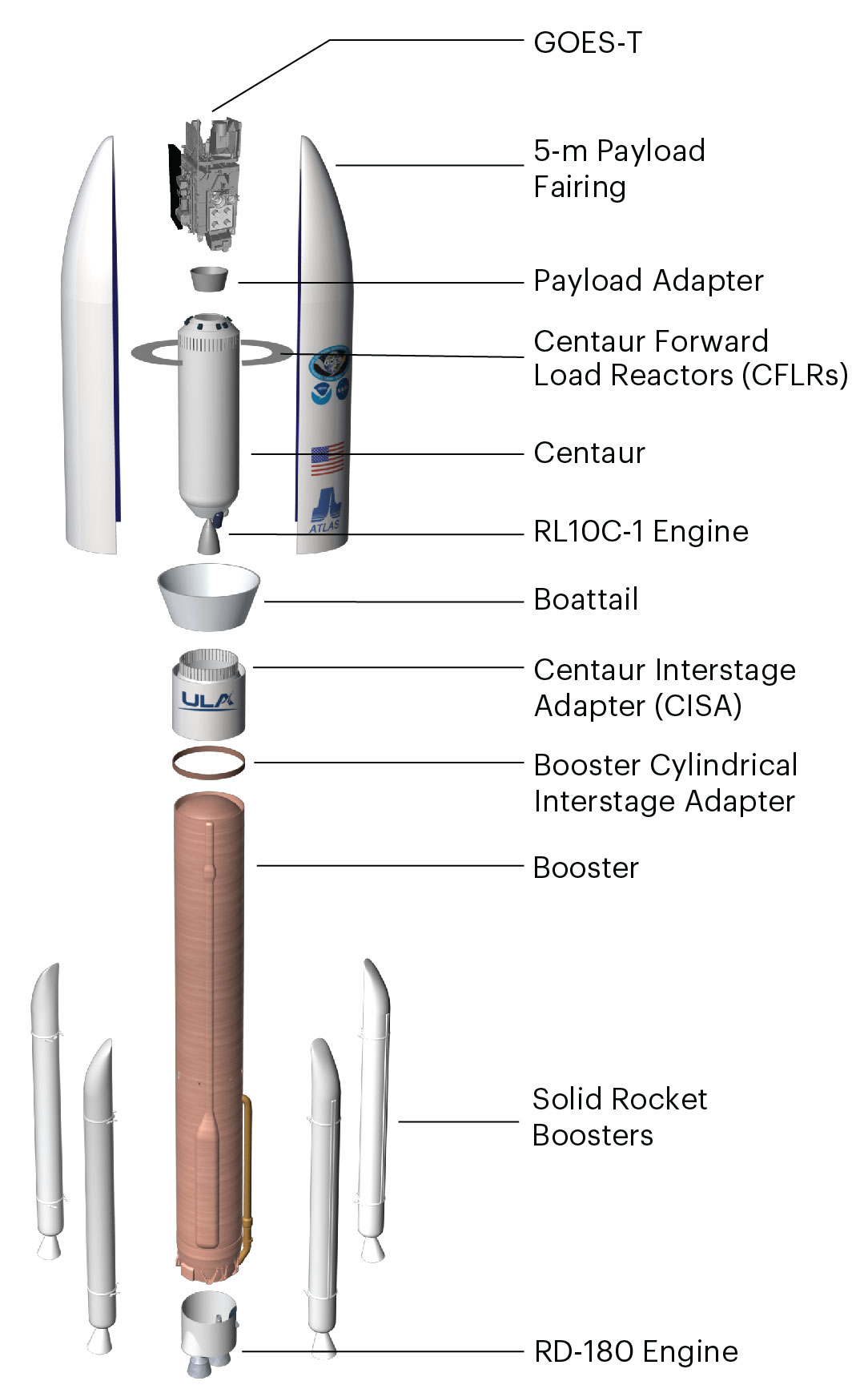Atlas V Launches GOES-T
A United Launch Alliance (ULA) Atlas V rocket carrying the GOES-T spacecraft for the National Oceanic and Atmospheric Administration (NOAA) and NASA lifted off on March 1 at 4:38 p.m. EST from Space Launch Complex-41 at Cape Canaveral Space Force Station.
Launch Webcast
Live updates
To keep up to speed with updates to the launch countdown, dial the ULA launch hotline at 1-877-852-4321.
Join the conversation at Twitter, Facebook, Instagram and
LinkedIn
#AtlasV #GOEST
Mission Overview
A United Launch Alliance (ULA) Atlas V 541 rocket will deliver the National Oceanic and Atmospheric Administration (NOAA) GOES-T spacecraft to an optimized geosynchronous transfer orbit. The optimized orbit places GOES-T closer to its final destination thereby conserving the satellite’s fuel supply for a longer mission life. The mission is conducted in collaboration with NASA. Liftoff will occur from Space Launch Complex-41 at Cape Canaveral Space Force Station, Fla.
GOES-T will provide NASA and NOAA with continuous imagery and atmospheric measurements of Earth’s Western Hemisphere, lightning detection and mapping, solar imaging and space weather monitoring. This is the third satellite in NOAA’s GOES-R Series, and will continue the revolutionary improvements brought by GOES-R and GOES-S, also launched on ULA’s Atlas V rocket.
NOAA manages the GOES-R Series program through an integrated NOAA-NASA office, administering the ground system contract, operating the satellites, and distributing their data to users worldwide. NASA’s Goddard Space Flight Center oversees the acquisition of the GOES-R spacecraft and instruments and NASA’s Launch Services Program at Kennedy Space Center manages the launches. Lockheed Martin designs, produces and tests the GOES-R series satellites. L3Harris Technologies provides the main instrument payload, the Advanced Baseline Imager, along with the ground system, which includes the antenna system for data reception.
Launch Vehicle
Payload Fairing (PLF)
The spacecraft is encapsulated in a 17-ft (5-m) diameter short payload fairing. The 5-m PLF is a sandwich composite structure made with a vented aluminum-honeycomb core and graphite-epoxy face sheets. The bisector (two-piece shell) PLF encapsulates both the Centaur and the satellite. The vehicle’s height with the 5-meter short PLF is approximately 196 ft (59.7 m).
Centaur
The Centaur second stage is 10 ft (3 m) in diameter and 41.5 ft (12.6 m) in length. Its propellant tanks are pressure-stabilized and constructed of corrosion-resistant stainless steel. Centaur is a cryogenic vehicle, fueled with liquid hydrogen and liquid oxygen, powered by an RL10C-1 engine producing 22,900 lbs (101.8 kilo-Newtons) of thrust. The cryogenic tanks are insulated with a combination of helium-purged blankets, radiation shields and spray-on foam insulation (SOFI). The Centaur forward adapter (CFA) provides structural mountings for the fault-tolerant avionics system and structural and electrical interfaces with the spacecraft.
Booster
The booster is 12.5 ft (3.8 m) in diameter and 106.5 ft (32.5 m) in length. The booster’s tanks are structurally rigid and constructed of isogrid aluminum barrels, spun-formed aluminum domes and intertank skirts. Booster propulsion is provided by the RD-180 engine system (a single engine with two thrust chambers). The RD-180 burns RP-1 (Rocket Propellant-1 or highly purified kerosene) and liquid oxygen and delivers 860,200 lbs (3.83 mega-Newtons) of thrust at sea level. Four solid rocket boosters (SRBs) generate the additional power required at liftoff, with each providing 371,550 lbs (1.6 mega-Newtons) of thrust. The Centaur avionics system, provides guidance, flight control and vehicle sequencing functions during the booster and Centaur phases of flight.

Flight Profile

Space Launch Complex-41 // Processing
Space Launch Complex-41, the East Coast home of the Atlas V rocket at Cape Canaveral Space Force Station in Florida, employs a “clean pad” concept of operations to ready launch vehicles and payloads for ascent into space. The rocket elements are assembled atop a Mobile Launch Platform inside the Vertical Integration Facility (VIF) located adjacent to the launch pad. The platform and fully stacked Atlas V then travel by rail approximately 1,800 feet northward from the VIF to the pad for the final countdown, fueling and liftoff. Complex 41 was constructed by the U.S. Air Force in the 1960s for the Titan rocket program. The site was rejuvenated in support of the Atlas V starting in the late 1990s.

1. Atlas Spaceflight Operations Center (ASOC)
Launch Control Center
Mission Director’s Center,
Mission Support
Teams,
Launch Vehicle Horizontal Processing &
Ordnance Installation
2. Delta Operations Center
Offline Vertical Integration (OVI):
Interstage Adapters, Centaur,
Boattail, Base Module & Centaur
Forward Load Reactor Deck
3. Spaceflight Processing Facility
Spacecraft Processing,
Testing & Encapsulation
4. Vertical Integration Facility
Launch
Vehicle Integration &
Testing, Spacecraft Mate &
Integrated Operations
Production

1. Promontory, UT
Solid Rocket Booster Fabrication
at Northrop Grumman
2. Denver, CO
ULA Headquarters &
Design Center Engineering
3. Harlingen, TX
Payload Adapter,
Booster Adapter &
Centaur Adapter Fabrication
4. Decatur, AL
Booster Fabrication & Final Assembly,
Centaur Tank Fabrication & Final Assembly
5. West Palm Beach, FL
RL10C-1 Engine Fabrication at
Aerojet Rocketdyne
6. Khimki, Russia
RD-180 Engine Fabrication at
NPO Energomash
7. Decatur, AL
5-m Payload Fairing
Fabrication at RUAG Space



